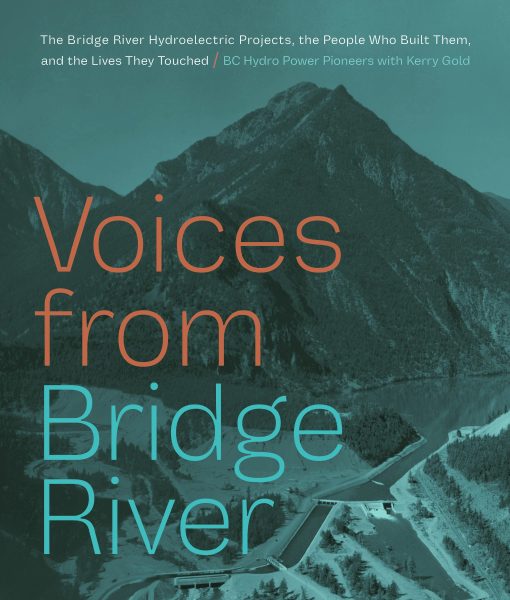
Voices from Bridge River: The Bridge River Hydroelectric Projects, the People Who Built Them, and the Lives They Touched
Review By Nevada Hinton
August 30, 2023
Voices from Bridge River explores the history of complex twentieth-century hydroelectric projects in the Bridge River region of the southwestern interior of British Columbia. Drawing heavily on oral interviews, the authors blend social history with environmental and business themes, highlighting changing landscapes by tracing the experiences of key decision-makers, developers, and people the projects affected. These range from the St’at’imc nation, whose lands and way of life were dramatically altered by the project, to Japanese-Canadians interned nearby during the Second World War. Voices from Bridge River makes a valuable contribution to the history of hydroelectricity and communities in British Columbia.
In 1912, surveyors Downton and Booth identified the potential of the 1200-foot natural drop from Bridge River into Seton Lake as the site of a potential hydroelectric project (3). Originally constructed by the Bridge River Power Company, the project was bought and further developed by BC Electric Railway (which later became BC Electric) in 1925. With a monopolistic strategy, BC Electric Railway bought up competing power companies and ultimately obtained control of almost all the power companies in southwest British Columbia (16). Because of the volatility of the Canadian economy during wartime years and the Great Depression, the Bridge River projects were halted and resumed multiple times throughout the decades. Following the Second World War, the demand for energy in British Columbia increased, and thus BC Electric’s interests in further development of the Bridge River Region continued. BC Electric completed the projects in 1960, shortly before being expropriated by the province of British Columbia in 1961 (123).
Voices from Bridge River is organized into eight lavishly illustrated chapters arranged by topic. Some chapters examine the political and business dimensions of the project, highlighting major investors, politicians, and powerful figures involved with BC Electric. Others examine the impact of the project on the St’at’imc communities, workers camps, and the Japanese internment camp. The St’at’imc nation, which had a powerhouse situated on their land at Shalalth, found their salmon fishery significantly depleted due to the hydroelectric dam (158, 49). The predominantly non-Indigenous settlements of Rexmount, Wayside, Congress, and the gold mining town of Minto City were inundated in the 1950s (149). The alterations to the landscape caused significant challenges for residents in the Bridge River area as their lands were flooded and food sources diminished.
Kerry Gold, an experienced journalist, relies on evidence gathered through oral interviews. Examples of these sources include BCER employees, Bridge River Indigenous leaders and coordinators, and Japanese Canadians interned at Bridge River. The lives and roles of figures who supported the Bridge River project are thoroughly described. However, the authors appear not to have used the BC Hydro’s archival records. Likewise, they cite few secondary sources, although they frequently reference Matthew Evenden’s Fish Versus Power (Cambridge University Press, 2004). It is in its use of oral interviews that this book is particularly welcomed.
The BC Hydro Power Pioneers is an organization of retired BC Hydro employees. Other books produced include Voices from Two Rivers which details the damming of the Peace and Columbia rivers, and People, Power and Progress, which details the Campbell River Power Projects. Voices from Bridge River holds BC Electric and wealthy investors accountable for the exploitation of land, ignorance of Indigenous territory, and environmental damage caused by the projects. At the same time, it calls the “state of the art” megaproject an “almost unfathomable achievement of human ingenuity and determination” (xiv). The book makes clear that the expropriation of BC Electric occurred in 1961, after the completion of the power projects (123). While the BC Hydro Power Pioneers succeed in showcasing the oral histories of those who lived in the Bridge River region, further discussion of the inherited legacy of BC Electric would have been welcomed.
Voices from Bridge River provides a welcome addition to the social, environmental, and energy history of British Columbia. Its reliance on the memories of those who lived in the region at the time make it a unique contribution to the study of hydroelectricity in Canada.
Publication Information
BC Hydro Power Pioneers and Kerry Gold. Voices from Bridge River: The Bridge River Hydroelectric Projects, the People Who Built Them, and the Lives They Touched. Vancouver: Figure 1 Publishing, 2022. 208 pp. $29.95 paper.
